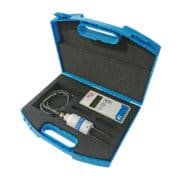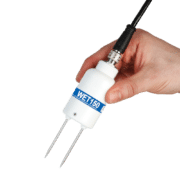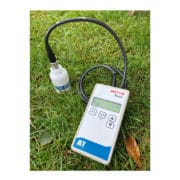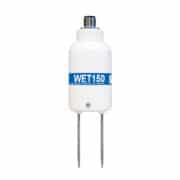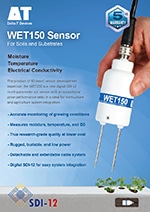- Overview
- Specification
- Accessories
- Product Resources How to Buy
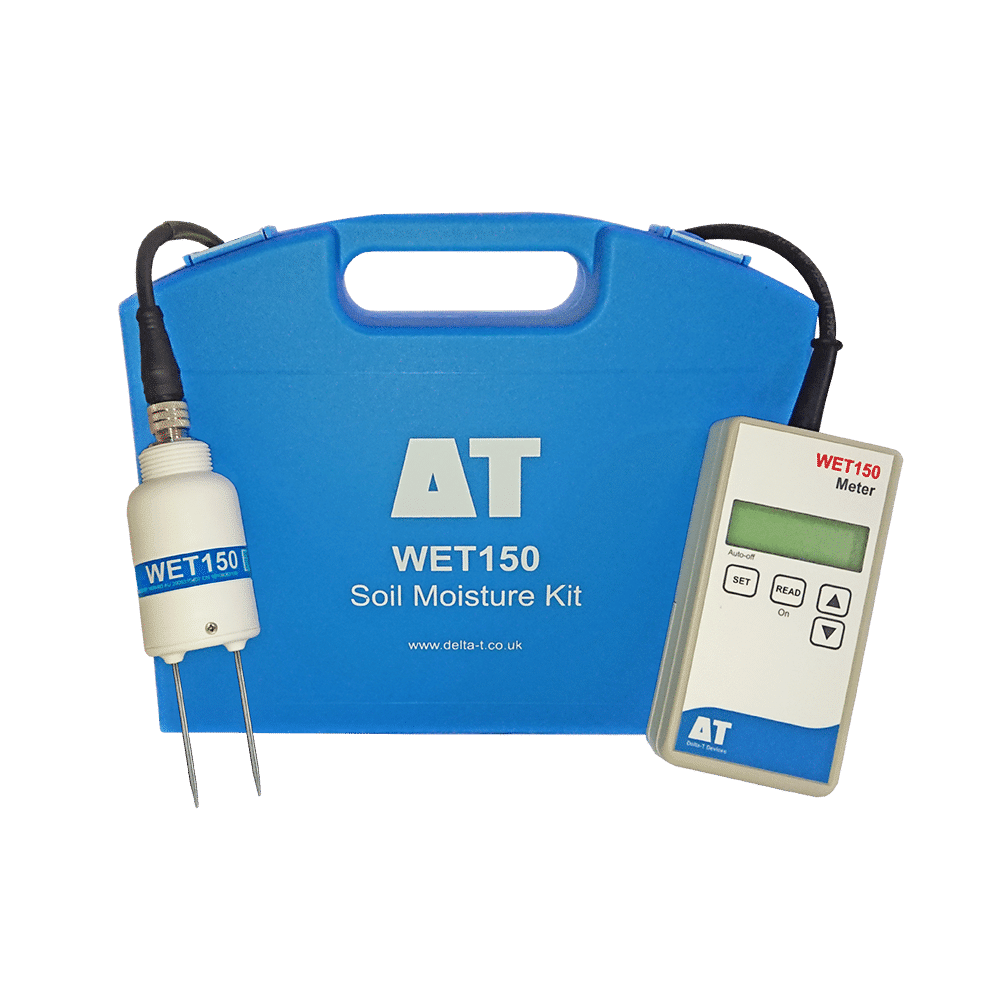
Testimonials
- Lower cost research-grade soil sensor kit for portable use
- Instant measurements of moisture, EC, and temperature
- Comes complete with readout meter and case
The WET150 Kit is a portable and rugged solution for researchers who need to assess moisture and salinity conditions in soils and substrates.
The Kit makes fast soil/substrate measurements of three crucial variables that influence plant growth: moisture content, temperature*, and electrical conductivity (EC) – a strong indicator of the general nutrient level.
*We recommend that the WET150 is used as a portable hand held sensor only in well-equilibrated environments where the air temperature doesn’t differ significantly from the soil/substrate temperature.
Kit Contents
The Kit comprises a WET150 Sensor, a WET150 hand-held readout meter, and a carry case. When correctly connected and tightened, the kit’s cables and connectors are completely watertight. The handheld WET150 Meter displays volumetric water content as % volume and EC in milliSiemens/metre.
The WET150 Meter is a lightweight and easy to use readout-only device (no data recording or other complications). Operation of the kit is straightforward – the user inserts the WET150 into the soil or substrate and presses the “Read” button on the meter to take and display the measurement.
The WET150 Sensor comes complete with calibrations for mineral and organic soils plus coir, peat, and mineral wool substrates soils.
Research Applications
The WET150 Kit can be used solely for precise reliable readings of soil/substrate water content. However, the inclusion of electrical conductivity (pore water conductivity ECp) measurement makes it particularly well suited to horticultural research in the areas of fertigation, precision irrigation, and soil salination monitoring.
WET150 Kit use in Commercial Horticulture
Details on the WET150 Sensor as a standalone device
Video – The Wet150 Sensor’s use in research and horticulture
Specification
WET150 Sensor
VOLUMETRIC WATER CONTENT |
PORE WATER CONDUCTIVITY (ECp) |
PERMITTIVITY |
BULK CONDUCTIVITY (ECb) |
TEMPERATURE |
|
ACCURACY |
± 0.03 m3.m-3 (3%)
|
See graph below this table
|
± (3% of reading + 0.8 ε’)
1 → 40
|
± (10mS.m-1 + 6%)
|
± 0.5°C
(0°C to +40°C range)
± 0.7°C
(-20°C to +60°C range)
|
± 5% of reading
40 → 80
|
|||||
RANGE |
Full range:
0 to 1.0 m3.m-3
|
See graph below this table
|
for ECp ≤ 800 mS.m-1
1 → 40
|
from 0 to 1200 mS.m-1
|
Full range:
-20°C to +60°C
|
Accurate range:
0.05 to 1.0 m3.m-3
ECb 0 to 500 mS.m-1
|
for ECp ≤ 500 mS.m-1
40 → 80
|
Accurate range:
0°C to +40°C
|
|||
OUTPUT |
SDI-12 protocol 1.3 (www.sdi-12.org) Providing water content, pore water conductivity, and temperature - together with base readings of permittivity and bulk conductivity. Outputs are exceptionally configurable. |
||||
POWER REQUIREMENT |
Operating voltage: 6 to 20 Volts Current consumption (typical values powered from 12 Volts): Active sensing: 22 mA average over 12 ms (average includes short peaks at 45 mA) Active results computation: 2 mA over 188 ms Idle: <0.5mA |
||||
ENVIRONMENTAL |
IP68, - 20 to + 60°C |
||||
SAMPLE VOLUME |
~55 x 70 mm diameter |
||||
Sample volume is weighted towards soil immediately surrounding the rods |
|||||
DIMENSIONS |
Overall: 143 x 40 mm dia Rods: 51 mm x 2.5 mm dia |
||||
WEIGHT |
Weight: 77g (excl. cable) |
||||
SENSOR CALIBRATIONS |
Individual sensors are interchangeable Recalibration advised every 5 years (depending on use) |
||||
SOIL CALIBRATIONS |
The WET150 Sensor comes complete with calibrations for mineral and organic soils plus coir, peat, and mineral wool substrates |
||||
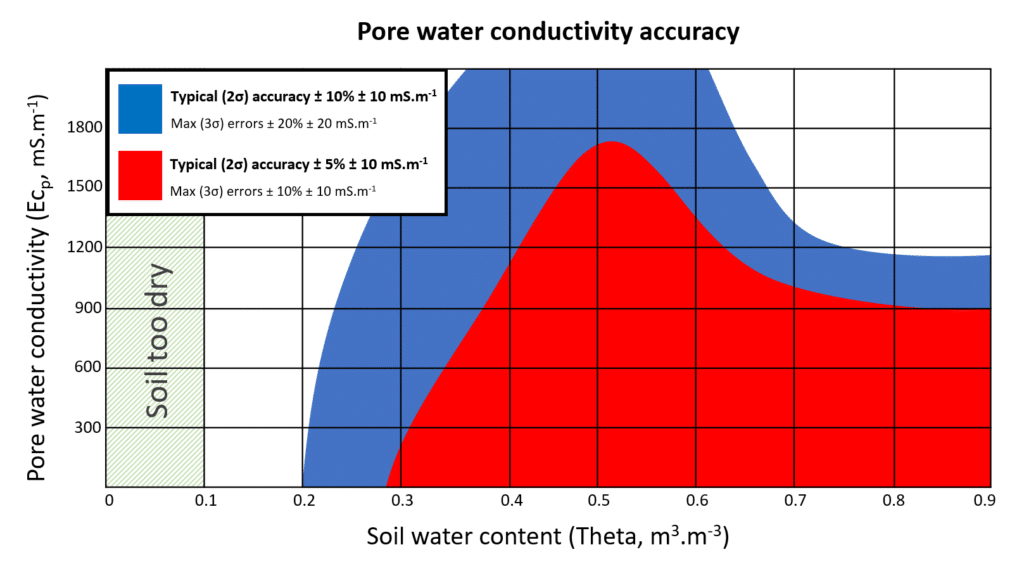
Notes: [1] The WET150 has been carefully optimised to provide accurate readings in soils and substrates - readings taken in water or air may not meet the full specification. [2] The ECp contour map is based on measurements from 30 sensors at 20°C in NPL* traceable media. Calculated ECp readings are derived from the Hillhorst equation, using the generalised “mineral” soil calibration and the default soil parameter = 4.1 * NPL is the UK's National Metrology Institute, developing and maintaining the national primary measurement standards.
WET150 Meter
INPUT CONNECTIONS |
1 WET150 multi-parameter water content sensor |
CONFIGURATION |
By keypad |
SENSOR EXCITATION |
Via SDI-12 |
POWER |
2 x AA alkaline batteries |
BATTERY LIFE |
> 2400 readings |
ENCLOSURE RATING |
IP65 |
TEMPERATURE RANGE |
0 to +40°C |
DISPLAY |
2 line x 16 character |
SIZE |
130 x 66 x 25 |
Accessories
Hardware
Main components and software
Mountings and enclosures
Installation accessories
Cables and networks
Remote communications
Spares and consumables
Power options
Other
Product Resources
Case Studies
-
Using the WET150 in Teesdale plant species recovery research 6 MB
Dr David Oatway makes extensive used of the WET150 Soil Sensor in urgent plant species recovery research (Upper Teesdale, North of England - SSI).
Filename: Teesdale_WET150_Case_Study_ver_1 -
Seven brief Delta-T Devices soil moisture sensor case studies 2 MB
A diverse selection of fascinating soil moisture related application stories.
Filename: Seven_brief_soil_moisture_sensor_case_studies_v1 -
Lualtek use the WET150 Sensor to take crucial ECp readings for their smart systems 993 KB
Italian Agritech specialist Lualtek explain the benefits of the WET150 Sensor.
Filename: WET150_Lualtek_ECp_case_study_version_1 -
BBRO use WET150 to tackle drought risk in sugar beet 2 MB
Delta-T Devices is providing soil sensors to the British Beet Research Organisation for use in important water deficit research projects.
Filename: BBRO_WET150_case_study_v.1 -
Swansea University use WET150 to investigate sea turtle nest conditions 613 KB
Swansea University scientists and Local Ocean Conservation (LOC) in Kenya are working together to safeguard endangered sea turtle species.
Filename: Case_Study_Sea_Turtles_Swansea_Uni_WET150_Sensor_v.1
Software
Videos
Manuals
- WET150 Kit Quick Start Guide 608 KBFilename: WET150_Kit_Quick_Start_Guide_v3
- WET150 Sensor User Manual 2 MBFilename: WET150-UM-01-2.0 (WET150_User_Manual_v2.0)
- WET150 Sensor Quick Start Guide 646 KBFilename: WET150_Quick_Start_Guide_v.3
- WET150 SDI-12 Programmer Guide 438 KBFilename: WET150 SDI-12 programmer guide v2
FAQs
-
How to check a WET150 is functioning
Question
I would like to check my WET150 sensor is functioning, how can I do this?
Answer
Use a WET150 meter to connect directly to the WET150 sensor and measure the “RAW” soil type setting: Permittivity, ECb and Temperature
Press the SET button on the WET150 meter.
Scroll down to “Soil type”, press SET.
Scroll to “RAW” press SET

Air test:
Hold sensor with rods pointing up in the air.
Press the “Read” button.
Permittivity (…õ) should = 1 (+/- 0.5)
ECb should = 0 (+/- 1mS.m-1).

Tap water test:
Fill a 1 litre container of tap water.
Insert the WET150 sensor into the middle of the water container, rods facing down into the water. Ensure the rods are covered by the water but not too deep – the water should not reach the side screws in the body of the WET150.
Ensure there is sufficient water around the rods (at least ~2cm from side walls and bottom of container).
*note this is very important! If the rods are too close to the side walls or bottom of the container, the sensing field will breach the container and you’ll be reading air/container material as well as the water. This will reduce the reading significantly.

Press the “read” button on the WET150 meter and note down the temperature and permittivity readings.

Using the temperature reading (in degC), work out what the estimated permittivity should be using: 87.48 – 0.365(T) where T is the temperature in degC:
87.48 – (0.365 x 24.7) = 78.5
WET150 permittivity (ɛ) should be reasonably close to the estimated value worked out using the temperature value above. Note: this is a rough test so the accuracy is not a strict limit.
The results from the temperature calculation above are 78.5 compared to the sensor reading of 79.5.
This is just a check to see if the sensor is in the correct region but, even with the published accuracy of +/-5%, the sensor is responding very closely.
Hanna fluid test:
Obtain a bottle of Hanna conductivity calibration fluid, for example the 1413uS/cm-1 (HI-70031P 1413µS/cm Conductivity Solution, x25 Sachets (hannainstruments.co.uk)

You will need enough fluid to fill a container so that, when the WET150 rods are inserted, they have a sufficient amount of fluid between the rods and the side and bottom of the container (at least ~2cm).
As above, insert the sensor into the middle of the fluid, rods facing down, water level no higher than the screws in the side of the body. Please note warnings about the sensor being too close to the side/bottom of the container – this will significantly reduce the reading.
ECb should match Hanna fluid +/- 5% +/-100uS.cm-1. However, take note of the temperature! The Hanna 1413 fluid specification is at 25degC. If the temperature is different from 25degC, use the look-up table on the side of the bottle to see what the reading will be at different temperatures
For example, at 24degC, the 1413uS/cm-1 solution should be 1386uS.cm-1 but, given the accuracy of the WET150, this means that any reading between 1216 and 1555uS.cm-1 is acceptable. In reality, we would expect it to be closer though: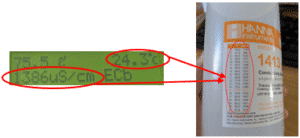
*Note: pay attention to the units. You can change the units on the WET150 meter so you can read the same units as the Hanna solution (uS.cm-1).


